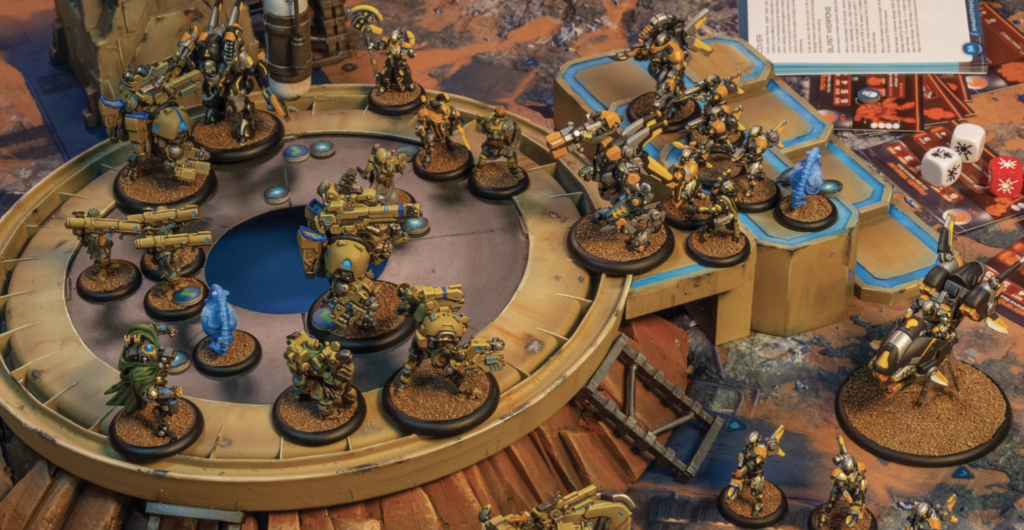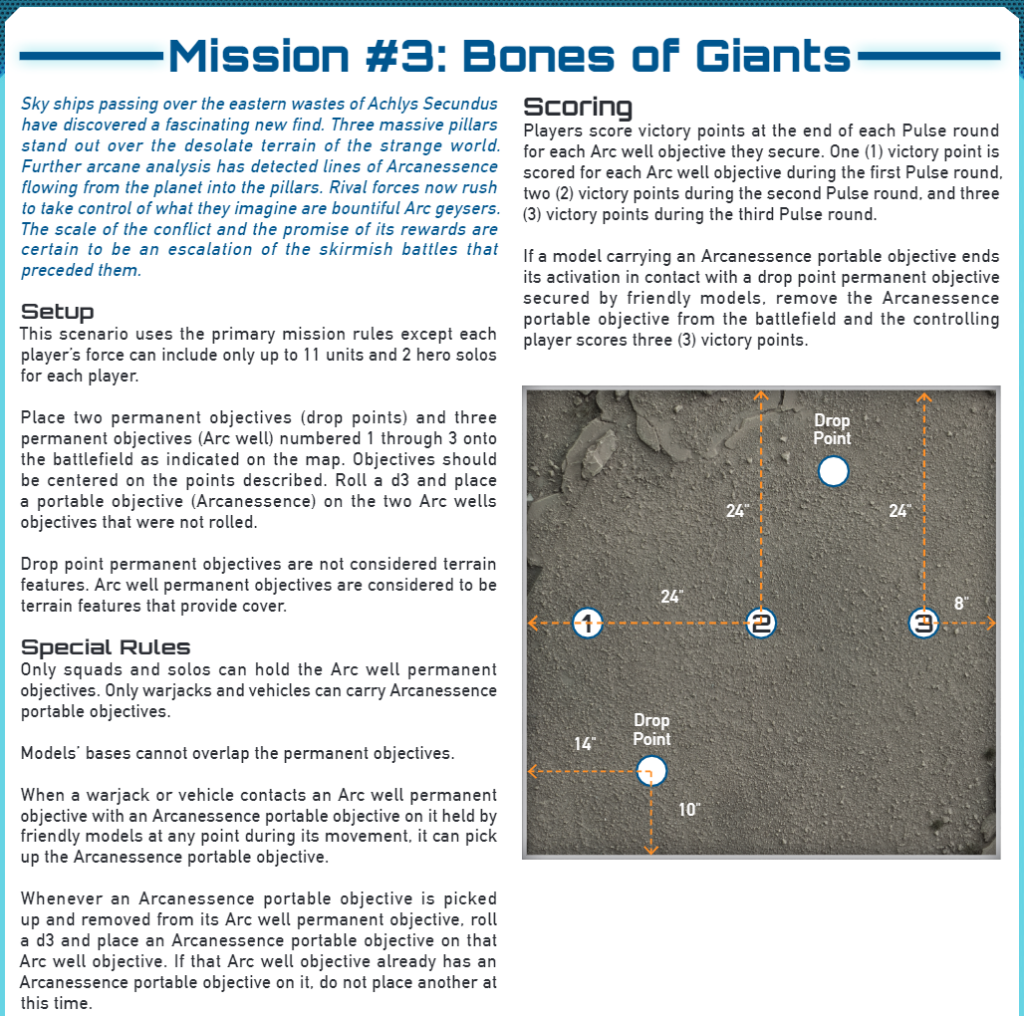Overview
For a faster Primary Mission game experience, consider playing a “Mid-Size” Sortie Mission instead:
- Use Primary Mission scenarios for all aspects, including board setup and scoring
- Exclude option for Secondary Missions
- 11 units, 2 free Hero solos
- 4-turn Pulse Rounds
This format increases the variety of scenarios you can play, and adds new dynamics to model interactions with increased ranges (thanks to the full size 48” x 48” board).

Background
Officially, games of Warcaster are played in one of two formats: Skirmish and Primary. From casual and unscientific examination of the Warcaster community, it seems like most players opt for Skirmish Missions when they get to play. Skirmish Missions allow any unit to score, and take notably less time to play, both of which make the format easier to play. It also helps that Skirmish Missions require fewer models – a bonus for newer players who don’t own as many models. Though these games keep moving along with 18 total turns (3 per player x 3 Pulse Rounds x 1 players = 18), they still can take between 90 and 120 minutes – even with experienced players.
The down side of Skirmish Missions is that the smaller board can lead to some vicious long-range attacks that feel downright dirty at times.
By contrast, Primary Missions spread the fight out across all 48×48 inches of the terrain, putting some check on the influence of superior ranges. However, with 5 turns per Pulse Rounds, the game duration increases by 66% over Skirmish games (5 turns x 3 Pulse x 2 players = 30). If a Skirmish Mission takes 90-120 minutes to play, this means that on average a Primary Mission would take 150-200+ minutes to complete! This duration alone makes Primary Missions less-appealing to play.
However, an unofficial but popular alternative game format has also emerged that features the larger boards of a Primary Mission, but doesn’t take as long to play: Sortie Missions.
Origin
The idea for this format first came from the Privateer Press “First Contact” single-day release event packet to promote the release of Warcaster. That event featured a series of games of escalating scale, starting with a 6 unit list and ending with a full 15 units and 3 free Hero solos. After the Skirmish Mission there was a scenario played on a 48″ x 48″ board with 11 units and 2 free Hero solos: Mission #3 “Bones of Giants”.

It is actually unclear whether this scenario was meant to use 3-turn Pulse Rounds (like the Skirmish game that you just completed) or should use 5-turn Pulse Rounds (like the Primary Missions do on the full size board). Just stating that question in writing suggests an obvious compromise: use 4-turn Pulse Rounds.
Of course, there was only the single scenario for such a format, which doesn’t make for enough variety in game play. But, given that this mission also played on 48″ x 48″, it seemed logical that any Primary Missions could be downsized to be a Sortie Mission as well.
Finally, since “Bones of Giants” made no mention of Secondary Objectives, it also made sense that Sortie Missions shouldn’t have those either.
Why play Sortie Missions?
Sortie Missions keep the essence of Primary Missions, but in a tighter format. With less units in the list, each choice is made more impactful, which enhances the list building experience. Having one less turn per Pulse Round over Skirmish Missions only adds 33% to the duration of the game (4 turns x 3 Pulse x 2 players = 24 turns, vs 18 for Skirmish); this is enough time to get units into scoring positions without dragging the action out as long. There are 11 standard scenarios for Primary Missions (vs only 6 Skirmish Missions), so you get almost twice the variety of games.
Being based on Primary Missions, Sortie Missions also have a heavy reliance on Squads for scoring objectives. Compared to Warjacks, Squads deal less damage with less accuracy, and are overall more vulnerable to enemy damage (despite having multiple targets). In contrast, Squads still have amazing mobility, and do require opponents to adapt their approach to engage them properly. Watching a Squad speed along into scoring position for the scenario showcases their intended role in the game. Sortie Missions can give you this experience in notably less time than a Primary Mission, which in turn can make you appreciate Squads a little more than you would from Skirmish Missions alone.
On the other hand, the absence of Secondary Missions is an improvement in the quality of game play compared to Primary Missions. The Secondary Missions are simply not balanced well-enough with one another to make their pursuit worth the work, and so the game is better off excluding them in general.
Criticism of Secondary Missions
For the effort involved and the victory points scored, there is little reason to play any Secondary Mission other than Recon.
Recon is by far the easiest way to accomplish the most victory points. It is not practical for an opponent to stop you for getting units within 5” of their deployment edge; in fact, this often happens just as a result of pursuing the scenario already. This Secondary Mission can even be triggered with any unit, and doesn’t even require an activation to score (so you could score it by playing a Cypher for added movement, among other possible tricks). This nets a player 3 points, which means a Secondary Objective must produce 4 victory points to compete against the value of Recon.
Players would have to trigger Body Count or Disrupt four times to get more victory points to exceed what Recon does in a single model movement. Potentially one could achieve better victory points by swarming an opponent with Squads to trigger Overrun, but this has to be done twice to pay off better than Recon. Salvage is just as bad, as you have to arrange for your melee Squads to deal the final hit on an enemy Warjack two times to exceed what Recon provides just once.
When factoring in the effort to make these Secondary Objectives land compared to the extreme ease of Recon, the choice of value is pretty clear. However, if both players have Recon as their Secondary Objective (which they absolutely should do), some of the charm of this game feature is lost – especially since Recon likely would trigger anyway through normal pursuit of scenario. Conceptually, Secondary Missions are really good, but without more robust choices of what to accomplish, the game is just better off with one less detail to track.
Community Support for Sortie Missions
Many in the online Warcaster community have already recognized this “Modified Primary” or “Mid-Size” format as a solid play option. Battle-Cruiser.net includes “Modified Skirmish or Primary” as an option in their spectacular online army builder.

Some areas are already hosting “Modified Primary Mission” Warcaster events. Seeing others independently recognizing the same concept in similar formats really emphasizes how intuitive of a concept this is for Warcaster.
Why are you calling these “Sortie Missions?”
All of the terms for these mid-size games are made up – it is an unofficial format. While “Modified Primary Mission” describes the game format well, it doesn’t flow as well when matched with “Skirmish Mission” or “Primary Mission”. “Sortie” isn’t a great term, but neither is “Primary” or even “Skirmish”. It seemed strange to promote a format while not having a term that meshes with the normal game formats, hence the coined term “Sortie Mission”.
Conclusion
When you are ready for more diversity in your scenarios and to see Squads function in their designed role, try out the Sortie Mission format. The larger ranges, wider spread of objectives, and greater dependence on Squads for scenarios really significantly shake up the game play for Warcaster without as much time as standard Primary Missions require.
Ok yeah I have to try this, thanks for the write-up!
Pingback: What you need to start Warcaster - Arcane Synthesis